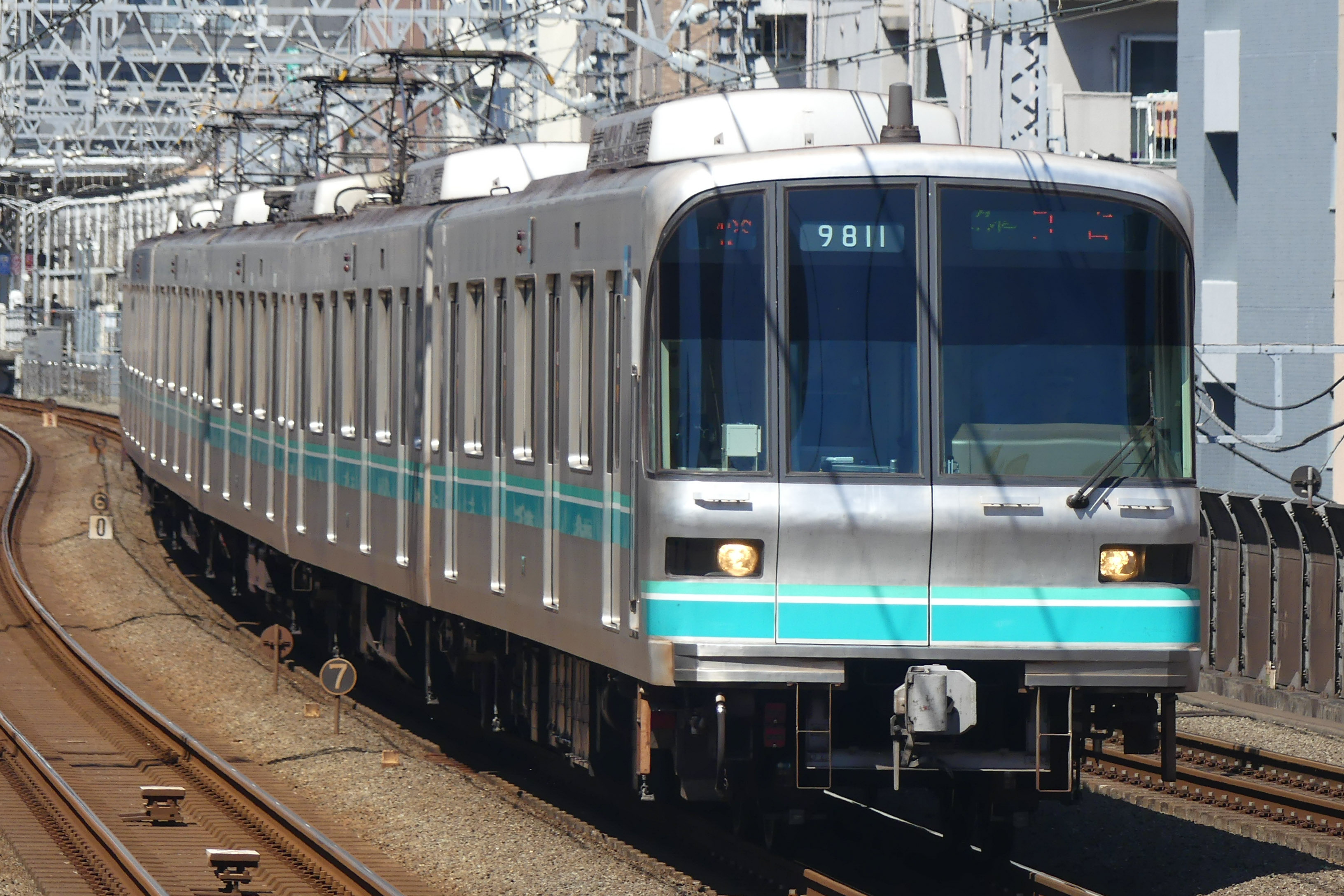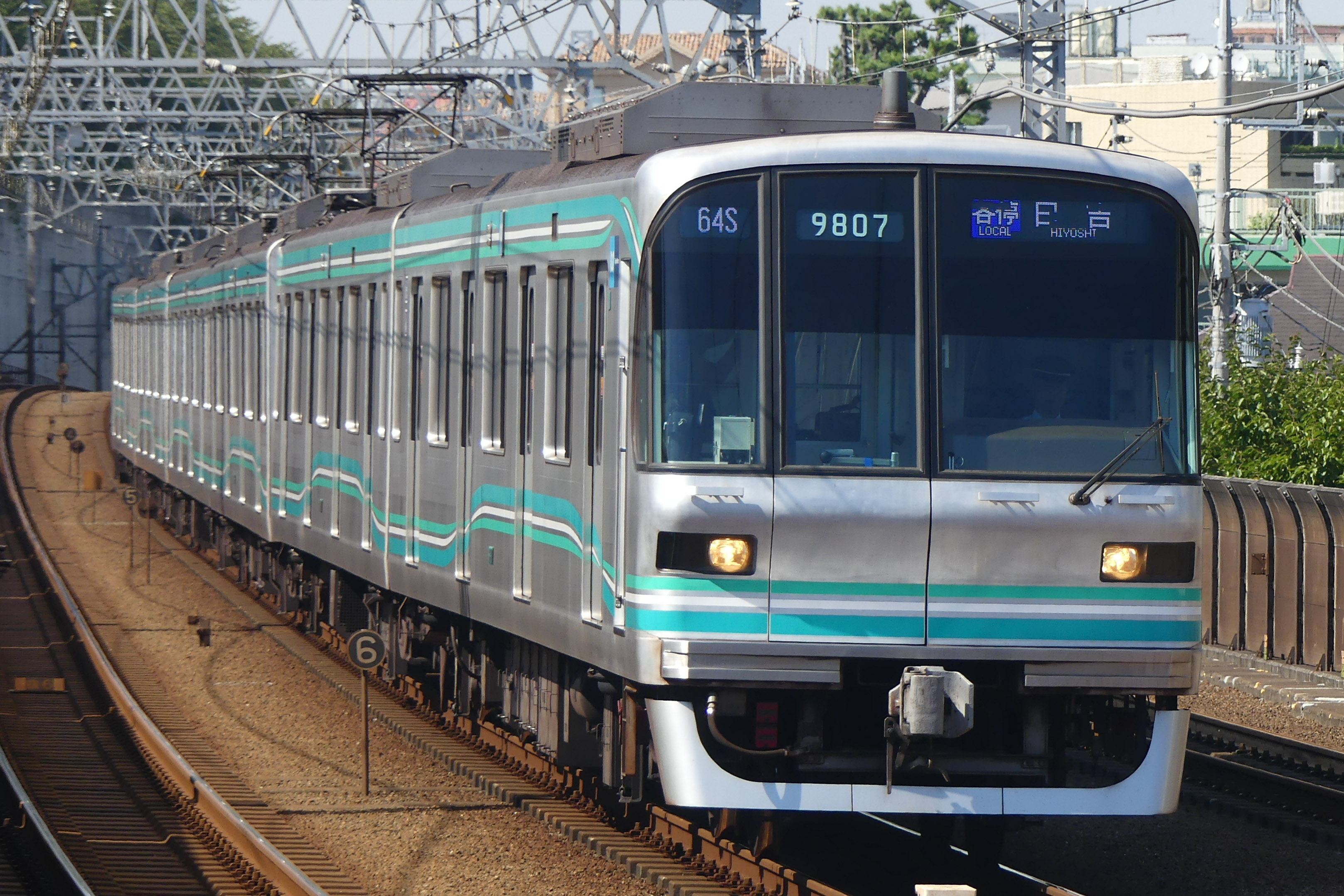Tokyo Metro 9000 series on:
[Wikipedia]
[Google]
[Amazon]
The is an
 , the fleet consists of 23 six-car sets (numbered 01 to 23), all based at Oji depot in Tokyo.
, the fleet consists of 23 six-car sets (numbered 01 to 23), all based at Oji depot in Tokyo.
File:Tokyo Metro 9000 series Prototype car interior 20170907.jpg, Interior of a prototype car, September 2017
File:Tokyo Metro 9000 series 1th-batch interior 20171021.jpg, Interior of a 1st batch set, October 2017
File:Tokyo Metro 9000 series 2th-batch interior 2 20171021.jpg, Interior of a 2nd batch set, October 2017
File:Tokyo Metro 9000 series 4th-batch interior 20170907.jpg, Interior of a 4th batch set, September 2017
File:Inside-TokyoMetro9123-1.jpg, Interior of a 5th batch set
File:Tokyo Metro 9000 series Prototype car transverse seating 20170907.jpg, A transverse seating bay at the end of a prototype car, September 2017
 The early sets (01 to 08) are scheduled to undergo a programme of refurbishment from 2016, with the first treated sets returning to service from August 2016. Internally, the transverse seating bays at the ends of cars will be replaced by longitudinal bench seats, and wheelchair spaces will be added to one end of each car. Externally, the refurbished sets will receive a revised livery with wavy turquoise and white stripes at waist height and shoulder height to make the line colour more visible at stations with platform edge doors.
The early sets (01 to 08) are scheduled to undergo a programme of refurbishment from 2016, with the first treated sets returning to service from August 2016. Internally, the transverse seating bays at the ends of cars will be replaced by longitudinal bench seats, and wheelchair spaces will be added to one end of each car. Externally, the refurbished sets will receive a revised livery with wavy turquoise and white stripes at waist height and shoulder height to make the line colour more visible at stations with platform edge doors.
File:Tokyometro-VFI-HR4820D.jpg, VVVF inverter of the 9000 series
File:TokyoMetro9000cab.jpg, Driver's cab of the 9000 series
File:Tokyometro9000-ATO.jpg, ATC and ATO underside equipment of the 9000 series
File:TokyoMetro9000-ATOmode.jpg, The black knob allows the driver to switch the mode of the operation between automatic and manual.
Tokyo Metro Namboku Line 9000 series information
{{Tokyo Metro trainsets Electric multiple units of Japan 9000 series Tokyu Car multiple units Kawasaki multiple units Nippon Sharyo multiple units Train-related introductions in 1991 1500 V DC multiple units of Japan
electric multiple unit
An electric multiple unit or EMU is a multiple-unit train consisting of self-propelled carriages using electricity as the motive power. An EMU requires no separate locomotive, as electric traction motors are incorporated within one or a numbe ...
(EMU) train type operated by the Tokyo subway operator Tokyo Metro
The is a major rapid transit system in Tokyo, Japan, operated by the Tokyo Metro Co. With an average daily ridership of 6.84 million passengers, the Tokyo Metro is the larger of the two subway operators in the city; the other being the Toei ...
on the Tokyo Metro Namboku Line
The is a subway line owned and operated by Tokyo Metro in Tokyo, Japan. The line runs between Meguro in Shinagawa and Akabane-Iwabuchi in Kita. The Namboku Line was referred to as Line 7 during the planning stages, thus the seldom-used officia ...
in Tokyo, Japan, since 1991.
Variants
 , the fleet consists of 23 six-car sets (numbered 01 to 23), all based at Oji depot in Tokyo.
, the fleet consists of 23 six-car sets (numbered 01 to 23), all based at Oji depot in Tokyo.
Prototype
A prototype four-car set was built byKawasaki Heavy Industries
(or simply Kawasaki) is a Japanese Public company, public multinational corporation manufacturer of motorcycles, engines, Heavy equipment (construction), heavy equipment, aerospace and Military, defense equipment, rolling stock and ships, headq ...
in 1990 (formed of cars 9101-9201-9301-9801) for testing on the Chiyoda Line
The is a subway line owned and operated by Tokyo Metro in Tokyo, Japan. On average, the line carries 1,447,730 passengers daily (2017), the second highest of the Tokyo Metro network, behind the Tozai Line (1,642,378).Yotsuya
is a neighborhood in Shinjuku, Tokyo, Japan.
It is a former ward (四谷区 ''Yotsuya-ku'') in the now-defunct Tokyo City. In 1947, when the 35 wards of Tokyo were reorganized into 23, it was merged with Ushigome ward of Tokyo City and Yodobas ...
to Komagome on 26 March 1996. This was achieved by renumbering the centre cars (9200 and 9300) of sets 02, 04, 06, and 08 as 9600 and 9700 cars which were inserted into sets 01, 03, 05, and 07. New-build (2nd batch) intermediate cars (9200-9300-9600-9700) were then inserted into sets 02, 04, 06, and 08. The resulting minor differences led to odd-numbered sets 01 to 07 being classified as "A sets", and even-numbered sets 02 to 08 becoming "B sets".
2nd batch
Four new six-car sets (09 to 13) plus the four sets of four additional intermediate cars described above were built byKawasaki Heavy Industries
(or simply Kawasaki) is a Japanese Public company, public multinational corporation manufacturer of motorcycles, engines, Heavy equipment (construction), heavy equipment, aerospace and Military, defense equipment, rolling stock and ships, headq ...
between 1995 and 1996, coinciding with the opening of the extension of the line from Yotsuya
is a neighborhood in Shinjuku, Tokyo, Japan.
It is a former ward (四谷区 ''Yotsuya-ku'') in the now-defunct Tokyo City. In 1947, when the 35 wards of Tokyo were reorganized into 23, it was merged with Ushigome ward of Tokyo City and Yodobas ...
to Komagome in March 1996. Floor height was reduced by compared with the 1st-batch sets from . Seat width was increased from .
3rd batch
Two new six-car sets (14 and 15) were built byTokyu Car Corporation Tokyu may refer to:
* Tokyu Group, a group of companies centered on Tokyu Corporation
** Tokyu Corporation, a Japanese railway company, the largest member and parent company of the group
** Tokyu Car Corporation, a former Japanese railway vehicle m ...
to coincide with the opening of the extension of the line from to on 20 September 1997. Externally and internally, these were identical to the 2nd-batch trains.
4th batch
Six new six-car sets (16 to 21) were built byNippon Sharyo
, formed in 1896, is a major rolling stock manufacturer based in Nagoya, Japan. In 1996, it abbreviated its name to "日本車両" Nippon Sharyō. Its shortest abbreviation is Nissha "日車". It was a listed company on Nikkei 225 until 2 ...
between 1999 and 2000 ahead of the opening of the extension of the line from Tameike-Sannō to Meguro
is a special ward in Tokyo, Japan. The English translation of its Japanese self-designation is Meguro City. The ward was founded on March 15, 1947.
Meguro is predominantly residential in character, but is also home to light industry, corporate ...
on 26 September 2000. The motored cars 3 (9300) and 4 (9600) in these sets have only one powered bogie, as opposed to two on earlier sets. Friction stir welding
Friction stir welding (FSW) is a solid-state joining process that uses a non-consumable tool to join two facing workpieces without melting the workpiece material. Heat is generated by friction between the rotating tool and the workpiece material ...
was used in the construction of these sets to produce a more attractive exterior finish.
5th batch
Two new six-car sets (22 and 23) entered service from 22 May 2009. These include a number of design improvements over earlier sets, including a redesigned front end, single-arm pantographs, and improved air-conditioning. The number of motored cars is reduced from four to three per 6-car set, with car 3 (trailer car) numbered in the 9400 series. Car 4 (9600) has both bogies powered. Seat width is increased to , and floor height is reduced to .Formations
Sets 01 to 21
The 1st to 4th batch sets (01-21) are formed identically as follows, with four motored ("M") cars and two non-powered trailer ("T") cars, and car 1 at the northern end. Motored cars 3 and 4 in sets 16 to 21 each have only one motored bogie. * Cars 2 and 4 each have two lozenge-typepantographs
A pantograph (, from their original use for copying writing) is a mechanical linkage connected in a manner based on parallelograms so that the movement of one pen, in tracing an image, produces identical movements in a second pen. If a line dr ...
.
* Cars 2 and 5 have wheelchair spaces.
* Car 4 is designated as a "mildly air-conditioned" car.
Sets 22 and 23
The two fifth-batch sets are formed as follows, with three motored ("M") cars and three non-powered trailer ("T") cars, and car 1 at the northern end. * Car 2 has one single-arm pantograph, and car 4 has two. * Cars 2 and 5 have wheelchair spaces. * Car 4 is designated as a "mildly air-conditioned" car.Interior
Refurbishment
 The early sets (01 to 08) are scheduled to undergo a programme of refurbishment from 2016, with the first treated sets returning to service from August 2016. Internally, the transverse seating bays at the ends of cars will be replaced by longitudinal bench seats, and wheelchair spaces will be added to one end of each car. Externally, the refurbished sets will receive a revised livery with wavy turquoise and white stripes at waist height and shoulder height to make the line colour more visible at stations with platform edge doors.
The early sets (01 to 08) are scheduled to undergo a programme of refurbishment from 2016, with the first treated sets returning to service from August 2016. Internally, the transverse seating bays at the ends of cars will be replaced by longitudinal bench seats, and wheelchair spaces will be added to one end of each car. Externally, the refurbished sets will receive a revised livery with wavy turquoise and white stripes at waist height and shoulder height to make the line colour more visible at stations with platform edge doors.
Future
The 9000 series sets are expected to be lengthened from 6 cars to 8 cars per set from 2022 as a means to mitigate congestion on the Namboku Line. In October 2021, two intermediate cars, numbered 9409 and 9509, were delivered fromKawasaki Heavy Industries
(or simply Kawasaki) is a Japanese Public company, public multinational corporation manufacturer of motorcycles, engines, Heavy equipment (construction), heavy equipment, aerospace and Military, defense equipment, rolling stock and ships, headq ...
' Hyogo plant.
Equipment
References
External links
Tokyo Metro Namboku Line 9000 series information
{{Tokyo Metro trainsets Electric multiple units of Japan 9000 series Tokyu Car multiple units Kawasaki multiple units Nippon Sharyo multiple units Train-related introductions in 1991 1500 V DC multiple units of Japan